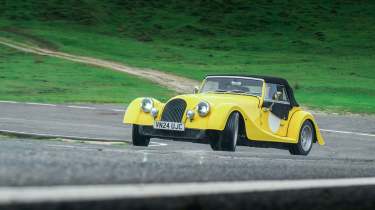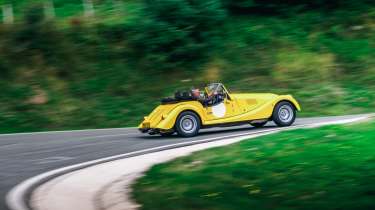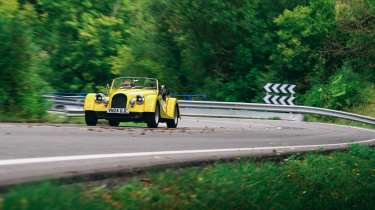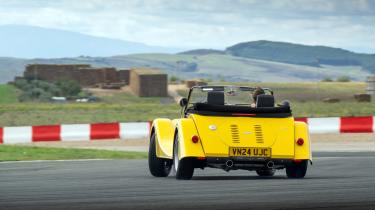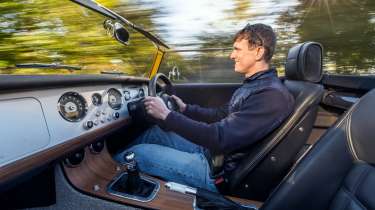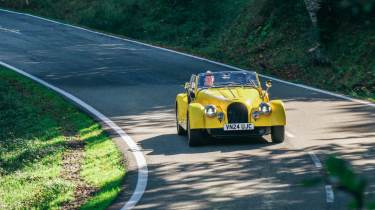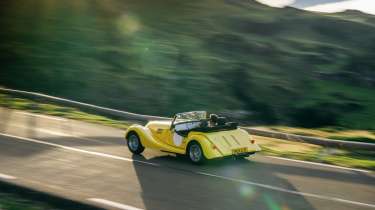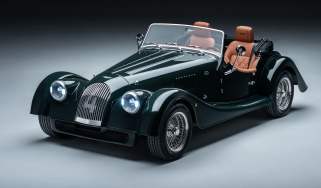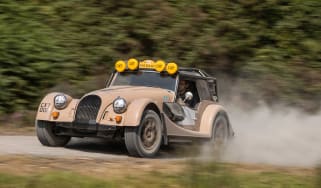Morgan Plus Four 2025 review – traditional charmer has modern appeal
There’s no confusing the Morgan Plus Four with a contender for sports car supremacy. But it’s capable enough and charming to no end
The Plus Four was Morgan’s logical follow-up to the Plus Six it launched in 2019. Except that this is actually the car that was developed first. When the company started working on its new bonded aluminium chassis that sits underneath both Six and Four, it was the lesser-cylinder version that was the initial focus.
To recap quickly, the CX-Generation chassis (CX being the Roman numerals for 110 – the number of years Morgan had been in existence when the chassis was unveiled in 2019) is the company’s latest (albeit now six-year-old) foundation for its four-wheeled offerings, replacing both the old steel chassis of models such as the 4/4 and Plus 4 and the previous aluminium chassis that underpinned the Aero range. The platform has twice the stiffness of the old aluminium chassis and weighs just 97kg. Attached at each corner is double wishbone suspension (no more sliding pillars at the front) and the chassis has been designed to provide a roomier cockpit for only a minimal increase in the wheelbase.
So far, so 21st century. However, attached to the chassis is a very traditional ash frame. Attached to that wooden frame is a body that closely mimics a design from the 1950s. Attached to the double wishbone suspension of this test car are old-fashioned wire wheels. In fact, it is apparently no small feat of modern engineering to have designed a low-offset wire wheel to work with the suspension. But they look old-fashioned.
More reviews
If you fold up the butterfly wings of the bonnet there is no doubting the contemporary credentials of the engine. Continuing Malvern’s connection with Munich, the BMW B48 unit is a modular version of the B58 straight-six in the Plus Four’s bigger brother, putting out 255bhp from its turbocharged two litres. What’s interesting from a visual perspective is how much spare room the shorter engine leaves over the nose of the car, undoubtedly shifting the weight balance more towards the centre.
As I potter through a small village that looks gloriously bucolic in the sunshine, I can’t help wondering what the housing equivalent of this Plus Four would be. A thatched cottage with the roof made of glassfibre tubes instead of reeds, perhaps? Astroturf on the lawn, obviously. And what would you find inside such a property? An electric Aga, maybe. Certainly one of those DAB Roberts radios.
Inside the Morgan, old mixes with a smattering of new. The small digital screen dead ahead blends in well with the traditional white-on-black analogue dials spread along the rest of the dash. There are no electric adjustments for anything – mirrors, windows or seats – but tucked away under the dash is a volume adjust for the optional Bluetooth speaker system. It’s not an entirely seamless union between past and present, with the airbag steering wheel being aesthetically awkward (although more for its ugliness than its modernity) and in the auto there is a conspicuously BMW gear selector, which has the jarring effrontery of a revolving door on a Norman church.
> Lotus Emira v Morgan Plus Four – four-cylinder Brits go head-to-head
Thankfully this car has the hipster’s choice of the six-speed manual ’box and, leaving the higgledy-piggledy collection of chocolate-box buildings behind and heading out through the surrounding fields, it seems like the right time to make good use of it. Even allowing for the fact that the sense of speed is greater because I’ve got the roof down and the side screens stowed behind the seats, the Plus Four feels genuinely quick. A dry weight of 1013kg isn’t Lotus Elise light, but there is certainly still a noticeable lack of inertia to the way it accelerates, and the claimed 0-62mph in 5.2sec feels conservative.
Three pedals is the standard spec of the Plus Four and although you gain 37lb ft of torque and drop the 0-62mph time to 4.8sec (and, interestingly, save 4kg) if you opt for the £2000 option of the eight-speed ZF auto, I don’t think you feel short-changed by the performance of the manual. The gearing is rather tall, but given that you tend to change up early and lean on the turbocharged torque, this isn’t the problem it might be with a naturally aspirated engine.
The ‘Sport Plus’ button in front of the gearlever actually makes quite a difference to the way you shift gear. Leave it untouched and the more relaxed way the revs respond to the throttle means you need to shift in a correspondingly sedate manner if you want smooth progress. Depress the button for a couple of seconds and it’s like you’ve given the slightly drowsy throttle response a slap round the chops with a refreshingly large salmon. There is more alertness and as a result you can shift as fast as the lever will move around the gate.
It’s a pleasant shift to use too. The action lacks the weight and mechanical tactility of the best, but there is satisfaction to be found. The clutch pedal feels quite strong in its springing and initially I found it hard to be really precise with the biting point at lower speeds (non-Sport Plus situations), but this is much less noticeable when you’re being more enthusiastic.
Sport Plus also has the added bonus of delivering more pep to the soundtrack coming from the sports exhaust. Work it really hard and you can induce a flurry of pops and crackles on the overrun. Overall it’s not the rortiest or most musical of engines but there is a slightly woolly mellowness to it that feels appropriate. There is one other acoustic accompaniment to journeys in the Morgan with the roof down: a whistle. Get enough speed for a decent slipstream to whip past the bodywork and from somewhere around the header rail of the windscreen there is a small shrill sound like a boiling kettle on a hob. Character, I believe it’s called.
Now, at this point I’d like to leave the more objective road testing aside for a few minutes and miles, because with the sun out and the hedgerows blurring, life feels pretty good in the Morgan. Really good, in fact. Aside from the added sense of speed and extra elbow room afforded by having the roof stowed and the side screens removed, there is also a wonderful feeling of freedom.
Even compared to other convertibles and roadsters, you feel more exposed in the Morgan; you’d have to brave the added impracticalities of an Ariel to feel more automotively naked. The rushing air and, yes, sense of added vulnerability is wonderfully liberating and invigorating and, I think, reawakens some of that sense of adventure that is intrinsically a part of everyone’s early years of driving. Familiar roads can suddenly provide a feeling of exploration.
Some of that freedom simply comes from the extra room at your disposal while remaining completely on your side of the road. Because the Plus Four is only 1650mm wide (a Smart Fortwo is 1663mm) you don’t feel so hemmed in between white line and kerb, and you can take a line through each corner rather than simply following your lane. The Four is even better than the Six in this regard as it is 106mm narrower than its brother thanks to revised suspension and bodywork.
There is another thing that a Morgan brings with it which you won’t find on any spec sheet: friendliness. A general aura of amiability surrounds the Plus Four. And because of the lack of barriers between you and the people passing by, you notice the added cheeriness in those who you encounter. The smiles. The politeness. The waves of thanks. The gobsmacked stares of children (although that might have been my considerable amount of unruly hair, billowing untamed in the breeze. A stray Afgan hound in a wind tunnel springs to mind).
Of course, a supercar will also get attention and some will be delighted by seeing a Lamborghini or Koenigsegg, but I don’t think supercars receive the near universal appreciation of the Morgan. Something about the nostalgic shape of the Plus Four makes it seem less aggressive and more approachable. To that extent, I suspect that if this Morgan and a McLaren were driven briskly down the same piece of road at exactly the same pace, more people would be annoyed by the older car from Woking. I think people just assume that the Morgan – classic car that they assume it is – can’t be travelling quickly enough to be perceived as a nuisance.
Whatever the reason for it, the general sense of bonhomie that you feel projected in your direction is lovely. Not that there is anyone to wave to out here. I’ve driven down this piece of road hundreds of times over the years but I’ve never known it so quiet. The first section is relatively smooth and here the Plus Four flows nicely, the suspension dealing with the bigger bumps well. Around the straight-ahead the front end can feel a little aloof through the electrically assisted wheel, but as soon as you get some lock on there is enough accuracy to guide the nose neatly through the faster corners.
Turning off onto a tighter and bumpier road things get a bit more interesting. It’s not a car that instantly breeds confidence to push really hard, as the sensations through steering and suspension are a little vague, so initially it’s not clear exactly how it might behave. The solution is actually to push harder, however, as the more you load the suspension and steering the easier it is to tell what’s happening.
As well as being narrower than the Plus Six, the Four rolls on significantly smaller wheels too – 15 inches as opposed to 19. Combined with the smaller engine, this means there is definitely a lighter feel to the Plus Four, and it also brings more progression as you start to push near the limits of the tyres. Perhaps surprisingly, the levels of adhesion still feel pretty high, but once you’ve got used to the way the car rolls into corners you can slide it in quite a neat, contained manner.
Curiously, the light front end feels best when you drive as though you’ve got cross-ply tyres and a big wooden-rimmed wheel in your hands to control them. If you agitate the nose a little as you turn in rather than trying to be super-smooth then you get a much better sensation of how the tyres are gripping and you can work the whole car harder as a result.
Of course, you haven’t got the monstrous torque of the Six to spin up the rear wheels, but that also means you can be more confident with the throttle mid-corner, happy in the knowledge that things won’t get too unruly too quickly. In fact, once you’ve attuned yourself to the ways and wiles of the Morgan it all feels nicely controllable when you do come to unstick the rear tyres (just as well given there is no stability or traction control), the slides happening mostly with momentum that naturally ebbs away.
A definite improvement over the Six is the shape of the seats. You still feel as though the whole caboodle needs to be set slightly lower, so that you’re sitting in, not on the car, but the bolsters now grip your torso much more securely and the squab has been given more shape and depth thanks to extra padding in the front section under your thighs. It all means you’re not left hanging on to the wheel and trying to brace with your knees through the bends when things get exciting.
The ride on this bumpier road is curious. It’s not bad, but it does feel quite busy. I would have thought, given the relatively low mass that it has to support, the suspension could be a bit more supple. The sensation is quite old-fashioned – despite all its modern underpinnings it reminds me of the 4/4 long-termer I used to run. Perhaps that’s exactly what the engineers wanted? Perhaps that’s what a Morgan customer wants?
Talking of suspension, Morgan introduced a Dynamic Handling Pack option for the Plus Four in 2024. The Nitron dampers and rear anti-roll bar represent significant, noticeable improvements to the Plus Four’s dynamic repertoire. There’s more control of its platform, more cohesion front-to-rear but the Morgan’s uniquely traditional appeal isn’t sacrificed in the name of adding capability. For £1995 it’s almost a no-brainer. A car so equipped featured at evo Car of the Year 2024.
evo Car of the Year 2024 verdict
‘The view out over the bonnet is so evocative. It feels like you’re on a real adventure every time you drive it,’ said James Taylor. ‘The scenery and surroundings seem so much more intense, which is a part of the thrill of driving.’
We all fell for the Morgan’s charms to some degree because the Plus Four is a beautiful car, beautifully made. It’s also a car that drives like it looks, which is great… up to a point. Its handling has improved with this version but it remains a classic driving experience, even though you really can tramp on – the turbocharged four delivers huge torque and has very little mass to shove along.
‘Dynamics are much improved but still olde worlde enough to feel completely different to any other contemporary sports car,’ said Richard Meaden. ‘I’m not a fan of the steering – I suspect the Avon tyres hobble it a bit – but overall the experience is impressive and heartwarming.’
Henry Catchpole reckoned you’d use it often if it was in your garage. ‘It turns every journey into an experience,’ he said, but added, ‘Conversely though, I’m not sure it’s the one you’d choose to take out just for a good drive.’ I felt the same. For me it’s an eight-tenths car; better to use the performance in a straight line and relax and enjoy the sights, sounds and smells of the countryside.”
Prices and rivals
The Plus Four is very much its own thing. Comparing it to other four-cylinder sports cars such as the Alpine A110 or 718 Boxster, the Morgan would be left at the bottom of the pile in traditional testing terms, even with the Dynamic Handling Pack. But, as I’ve hopefully communicated, the Morgan also provides emotions that neither of those more modern cars can. You have to pay handsomely for this uniqueness, because at £69,996 basic (£74,406 for the car seen at eCoty 2024) this is a very expensive four-cylinder car. But given its only true rival is the Plus Six, which doesn’t have a manual ’box, doesn’t handle quite as sweetly and costs £17k more, the Plus Four actually makes a perplexing case for being good value.
Certainly looking at the Morgan parked up at the end of the day in the lovely mellow evening rays, I can see the appeal. Even as I wrestle with the roof as the temperature finally drops, I manage to find a strange satisfaction in an unfurling process that most would now expect to be completed through the simple push of a button. Old-fashioned. Then there are LED beams showing me the way home. Modern. It’s vinyl heard through Bluetooth headphones. It’s choosing to turn off some bulbs and light some candles. It’s A Wonderful Life on a QLED TV at Christmas. It’s perplexingly anachronistic in parts, but a Morgan has still got its place in 2025.
Specs
| Engine | In-line 4-cyl, 1998cc, turbocharged |
| Power | 255bhp @ 5500rpm |
| Torque | 258lb ft @ 1000-5000rpm |
| Weight (dry) | 1013kg |
| Power-to-weight (dry) | 256bhp/ton |
| 0-62mph | 5.2sec |
| Top speed | 149mph |
| Basic price | £69,996 |
